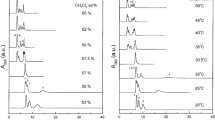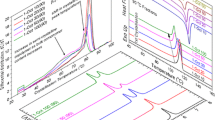Abstract
Gradient polymer elution chromatography (GPEC) is a reliable polymer separation method applied in many polymer labs. For many polymer researchers and HPLC users, GPEC is an unknown separation method. However, many of the basic rules regarding polarity of solvents, polymers and stationary phases of traditional HPLC are applicable also in GPEC. The main differences are based on the nature of high molar mass polymers, limited solubility and a molar mass distribution.


Similar content being viewed by others
References
Staal WJ (1996) Gradient polymer elution chromatography. A qualitative study on the prediction of retention times using cloud-points and solubility parameters. PhD thesis, Eindhoven University of Technology (ISBN 90-386-0126-3)
Cools PJCH (1999) Characterization of copolymers by gradient polymer elution chromatography. PhD thesis, Eindhoven University of Technology (ISBN 90-386-0970-1)
Staal MPB (2005) Synthesis and characterization of compatibilizers for blends of PA and ABS. PhD thesis, Eindhoven University of Technology (ISBN 90-386-2937-0)
Philipsen HJA, Klumperman B, German AL (1996) characterization of low-molar-mass polymers by gradient polymer elution chromatography 1. Practical parameters and applications of the analysis of polyester resins under reversed phase conditions. J Chromatogr A 746:211–224
Glöckner G (1991) Gradient HPLC of copolymers and chromatographic cross-fractionating. Springer, Berlin (ISBN 3-540-52739-7)
Engelhardt H (1975) Hochdruck-flüssigkeits chromatographie. Springer, Berlin (ISBN 3-540-07320-5)
Mori S, Barth HG (1999) Size exclusion chromatography. Springer Verlag, Berlin (ISBN 3-540-65635-9)
Pasch H, Trathnigg B (1998) HPLC of polymers. Springer Verlag, Berlin (ISBN 3-540-61689-6)
Van der Maeden FPB, Biemond MEF, Janssen PCGM (1978) Oligomer separations by gradient elution high-performance liquid chromatography. J Chromatogr A 149:539–552
Hansen CM (1967) The three dimensional solubility parameter -key to paint component affinities 1- solvents, plasticizers, and resins. J Paint Technol 39:104
Striegel M (2020) Method development in interaction polymer chromatography. Trends Anal Chem 130:115990. https://doi.org/10.1016/j.trac.2020.115990
Striegel AM (2003) Determining and correcting “moment bias” in gradient polymer elution chromatography. J Chromatogr A 996:45–51. https://doi.org/10.1016/j.chroma.S0021-9673(03)00536-3
Brun Y, Alden P (2002) Gradient separation of polymers at critical point of adsorption. J Chromatogr A 966:25–40
Philipsen HJA (2004) Determination of chemical composition distributions in synthetic polymers. J Chromatogr A 1037:329–350
Staal WJ, Cools P, van Herk AM, German AL (1993) On-line extraction of polymers, oligomers, additives and monomers by multiple solvents on packed HPLC columns. Chromatographia 37(3/4):218–220
Radke W, Schollenberger M (2011) Size exclusion chromatography-gradients, an alternative approach to polymer gradient chromatography: 2. Separation of poly(meth)acrylates using size exclusion chromatography-solvent/non-solvent gradient. J Chromatogr A 1218:7828–7831. https://doi.org/10.1016/j.chroma.2011.08.090
Brandrup J, Immergut EH, Grulke EA (2003) Polymer handbook, 4th edn. Wiley, Hoboken (ISBN 978-0-471-47936-9)
Staal BBP (2005) Characterization of (co)polymers by MALDI-TOF-MS. PhD thesis, Eindhoven University of Technology (ISBN 90-386-2826-9)
Niezen LE, Staal BBP, Lang C, Pirok BWJ, Schoenmakers PJ (2021) Thermal modulation to enhance two-dimensional liquid chromatography of polymers. J Chromatogr A 1653:462429. https://doi.org/10.1016/j.chroma2021.462429
Staal WJ (2001) Method for detecting polymers in a solution, detector system and chromatography apparatus containing such a detector system. United States Patent US 6,187,595 B1, 13 Feb 2001
Pirok BWJ, Mengerink Y, Peters RAH (2021) Molecular correlative material characterization: advantages for polymer analysis using liquid chromatography. LCGC Eur 34:172–180
Neue UD (1997) HPLC columns, theory, technology, and practice. Wiley VHC Inc, New York (ISBN 0-471-19037-3)
Fabrice G (2021) Rebirth of recycling liquid chromatography with modern chromatographic columns: extension to gradient elution. J Chromatogr A 1653:462424. https://doi.org/10.1016/j.chroma.2021.462424
Acknowledgements
The author greatly acknowledge the University of Amsterdam and industrial and governmental partners in promoting polymer separation techniques in general. Further thanks to the Discussion Group on Separation methods for Polymers (DSP) (part of the Royal Netherlands Chemical Society KNCV) promoting GPEC and other polymer separation techniques.
Author information
Authors and Affiliations
Corresponding author
Additional information
Publisher's Note
Springer Nature remains neutral with regard to jurisdictional claims in published maps and institutional affiliations.
Rights and permissions
About this article
Cite this article
Staal, W.J. Gradient Polymer Elution Chromatography (GPEC): Under-Estimated Powerful Tool for Polymer Characterization—A Perspective. Chromatographia 85, 1–5 (2022). https://doi.org/10.1007/s10337-021-04111-1
Received:
Revised:
Accepted:
Published:
Issue Date:
DOI: https://doi.org/10.1007/s10337-021-04111-1




